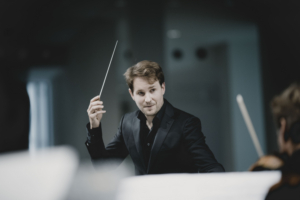Review: BEETHOVEN: SYMPHONY NO.7, Southbank Centre

![]() As part of the Southbank Centre's Classical Season, the Philharmonia Orchestra performed a fantastic Sunday matinee of Beethoven's Symphony No.7, along with Schumann's overture to Manfred and Mendelssohn's superb Violin Concerto.
As part of the Southbank Centre's Classical Season, the Philharmonia Orchestra performed a fantastic Sunday matinee of Beethoven's Symphony No.7, along with Schumann's overture to Manfred and Mendelssohn's superb Violin Concerto.
The concert began with Schumann's Overture, Manfred. The young Schumann was so deeply moved when he read Byron's Poem 'Manfred' in 1829 that he mediated on it over nearly twenty years before composing the incidental music for the poem in 1848. This is a brooding and darkly passionate piece that explores the romanticism of the poem. The tormented Manfred longs for his own death, after a mysterious past transgression which resulted in the death of his beloved Astarte.
The overture opens with a single bar of three agitated chords, leading to an oboe introduction, bringing a wildness and passion. Conductor Clemens Schuldt was on typically energetic form, exploring the extreme chromaticism of the piece and the repetition of the darker phrases to give the audience a real sense of the torment of Manfred. The quiet of the final bars was very powerfully performed, with a real sense of finality and darkness.
The highlight of the afternoon was Mendelssohn's Violin Concerto, which provided a welcome contrast to the innate sadness and torment of Schumann's piece. The concerto premiered in 1845 and is a whirlwind of romantic and passionate sentiment. Since then it has become one of the most frequently performed and well-loved instrumental concertos.
The first movement is haunting and melodic, leading to a more gentle and pastoral melody. It also features the almost-immediate introduction to the solo violin, which was almost unheard of at the time of composition. The recital featured the fabulous Grammy-Award winner; soloist Augustin Hadelich. Like all gifted soloists, he uses his violin as an extension of himself, with a deft and precise musicality. He is hypnotic to watch, with a breathless energy and delicate refinement.
The movement's climax reveals one of Mendelssohn's unique traits; the intensity is not created with a fortissimo climax, but with a quiet passage. In this composition, the violinist's cadenza, or extended solo, comes at the middle of the piece. Hadelich passionately explores all the cadences of the piece, especially the playful elements that reflect Mendelssohn's influences ever since he composed his Overture to A Midsummer Night's Dream when he was just 17.
Beethoven composed his Symphony No.7 in 1811, while trying the improve his health at a spa. It is an often-forgotten work, slotted between the famous fifth and masterful ninth, but was highly praised at the time, particularly by Richard Wagner, who called it 'the apotheosis of the dance'.
The Philharmonia Orchestra was on scintillating form, effortlessly exploring the flow and lyricism of the piece. It begins with a dark and foreboding tone, but soon moves in the second and third movements to become more joyful and lighter. The second movement of the Allegretto relies heavily on strings and the energy of the performance was palpable.
The finale, Allegro con brio, opens with a four-note motif that is very reminiscent of those famous opening notes of the fifth. It was joyful, fast and furious and performed with incredible energy.
As ever, this was the Southbank Centre showing an exciting and accessible programme. This was a bright and vivacious concert that was a wonderful introduction to the eight matinees in this Classical Season.
The Southbank Centre's Classical Season continues until July 2020
Photo Credit: Sammy Hart
Reader Reviews
Videos

